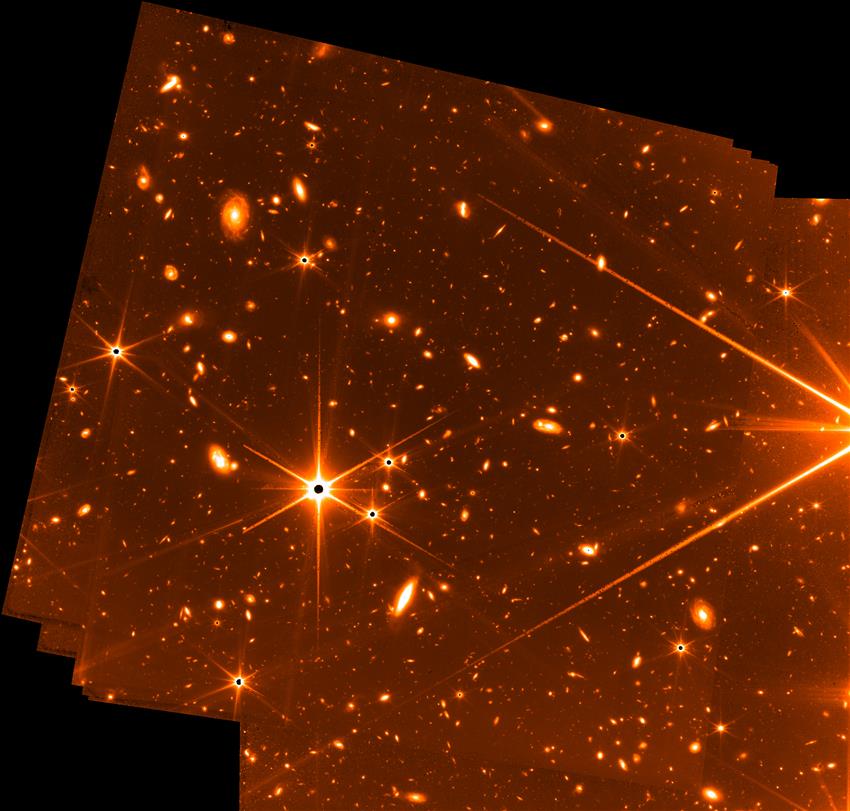Webb's Fine Guidance Sensor provides a preview

This Fine Guidance Sensor test image was acquired in parallel with NIRCam imaging of the star HD147980 over a period of eight days at the beginning of May. This engineering image represents a total of 32 hours of exposure time at several overlapping pointings of the Guider 2 channel. The observations were not optimized for detection of faint objects, but nevertheless the image captures extremely faint objects and is, for now, the deepest image of the infrared sky. The unfiltered wavelength response of the guider, from 0.6 to 5 micrometers, helps provide this extreme sensitivity. The image is mono-chromatic and is displayed in false color with white-yellow-orange-red representing the progression from brightest to dimmest. The bright star (at 9.3 magnitude) on the right hand edge is 2MASS 16235798+2826079. There are only a handful of stars in this image – distinguished by their diffraction spikes. The rest of the objects are thousands of faint galaxies, some in the nearby universe, but many, many more in the high redshift universe. (Credits: NASA, CSA, FGS team)
Webb's Fine Guidance Sensor (FGS) – developed by the Canadian Space Agency (CSA) and designed to find and lock onto cosmic targets – recently captured a view of stars and galaxies that provides a tantalizing glimpse at what the telescope's science instruments will reveal in the coming weeks, months, and years.
FGS has always been capable of capturing imagery, but its primary purpose is to enable accurate science measurements and imaging with precision pointing. When it does capture imagery, the imagery is typically not kept: Given the limited communications bandwidth between L2 and Earth, Webb only sends data from up to two science instruments at a time. But during a week-long stability test in , it occurred to the team that they could keep the imagery that was being captured because there was available data transfer bandwidth.
The resulting engineering test image has some rough-around-the-edges qualities to it. It was not optimized to be a science observation; rather, the data was taken to test how well the telescope could stay locked onto a target, but it does hint at the power of the telescope. It carries a few hallmarks of the views Webb has produced during its postlaunch preparations. Bright stars stand out with their six long, sharply defined diffraction spikes – an effect due to Webb's six-sided mirror segments. Beyond the stars, galaxies fill nearly the entire background.
The result – using 72 exposures over 32 hours – is among the deepest images of the universe ever taken, according to Webb scientists. When the FGS's aperture is open, it is not using colour filters like the other science instruments, meaning it is impossible to study the age of the galaxies in this image with the rigour needed for scientific analysis. But even when capturing unplanned imagery during a test, Webb is capable of producing stunning views of the cosmos.
"With the Webb telescope achieving better-than-expected image quality, early in commissioning we intentionally defocused the guiders by a small amount to help ensure they met their performance requirements. When this image was taken, I was thrilled to clearly see all the detailed structure in these faint galaxies. Given what we now know is possible with deep broad-band guider images, perhaps such images, taken in parallel with other observations where feasible, could prove scientifically useful in the future," said Neil Rowlands, program scientist for Webb's Fine Guidance Sensor, at Honeywell Aerospace.
The FGS image is coloured using a reddish colour scheme that has been used for Webb's other engineering images throughout commissioning. In addition, there was no "dithering" during these exposures. Dithering is when the telescope repositions slightly between each exposure. In addition, the centres of bright stars appear black because they saturate Webb's detectors, and the pointing of the telescope didn't change over the exposures to capture the centre from different pixels within the camera's detectors. The overlapping frames of the different exposures can also be seen at the image's edges and corners.
In this engineering test, the purpose was to lock on to one star and test how well Webb could control its "roll"– literally, Webb's ability to roll to one side like an aircraft in flight. That test was performed successfully – in addition to producing an image that sparks the imagination of scientists who will be analyzing Webb's science data.
While Webb's four science instruments will ultimately reveal the telescope's new view of the universe, the FGS is the one element that will be used in every single Webb observation over the course of the mission's lifetime. It has already played a crucial role in aligning Webb's optics. Now, during the first real science observations made in June and once science operations begin in mid-July, it will guide each Webb observation to its target and maintain the precision necessary for Webb to produce breakthrough discoveries about stars, exoplanets, galaxies, and even moving targets within our solar system.
Abridged text reprinted courtesy of NASA